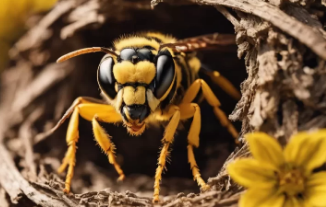Detailed Look at Wasp Life Stages
Wasps, members of the Hymenoptera order, go through a fascinating life cycle comprising four stages: egg, larva, pupa, and adult. The eggs are typically tiny, cylindrical, and pale. Larvae, which are legless and grub-like, exhibit a whitish hue. Pupae stages are characterized by their cocoon-like appearance without wings. Adult wasps display a remarkable diversity in size, color, and form, varying greatly across different species.
They, often misunderstood and feared for their stinging capabilities, play a crucial role in ecosystems as pollinators and pest controllers. This diverse group of insects encompasses various species, each with its own distinct characteristics. In this exploration, we delve into the fascinating world of them, shedding light on different varieties and their remarkable traits

Comprehensive Categorization of Wasps
They are predominantly classified into three distinct types: social, solitary, and parasitic. Each type has unique behaviours and roles in the ecosystem:
- Social Insects, such as yellow jackets and hornets, are known for their communal nests and can be particularly defensive.
- Solitary Insects, in contrast, operate alone. They demonstrate a range of nesting behaviors, from burrowing in the ground to constructing mud nests or even taking over existing nests.
- Parasitic Insects play a vital role in natural pest control, laying eggs on or in other insects, with their larvae eventually consuming the host.
Solitary Wasps: Independent Predators
Solitary wasps are fascinating for their independence. They do not form the large colonies typical of their social counterparts. These predatory insects exhibit diverse nesting habits, including ground burrows, plant cavities, mud nests, or even repurposed nests. The female is solely responsible for all aspects of nest construction, hunting, and rearing the young. A notable species within this group is the velvet ant, which is a type of them. This species is known for its distinctive appearance and potent sting.
Social Insects,: Complex Colony Dynamics
Social insects,, including the commonly known yellow jackets and hornets, are intriguing for their complex social structures. They form colonies that last for a season, with only fertilized queens surviving the winter to start new colonies in spring. Their nests, often made of a paper-like substance from chewed wood and saliva, can be located in various places, including trees, eaves, or underground. They are known for their protective nature, especially near their nests.
Parasitic Wasps: Eco-Friendly Pest Control
Parasitic insects, often overlooked, are crucial in controlling pest populations. By laying their eggs in or on other insects, they ensure that their larvae have a ready food source, inadvertently helping to manage populations of various pest insects. Their role is especially valued in agriculture and horticulture, where they naturally regulate pest species.
As we continue to explore the world of wasps, ongoing research and technological advancements promise new revelations. From the potential medicinal applications of wasp venom to the insights gained from studying their behaviors in diverse environments, the future holds exciting possibilities for unlocking the secrets of these remarkable insects and their contribution to the intricate web of life
Effective Wasp Management Strategies
Dealing with it, particularly in residential or commercial settings, requires careful consideration. While DIY methods exist, they may not always be safe or effective. Consulting a pest management professional is the best course of action. These experts can offer tailored advice and solutions, ensuring safe and effective wasp control tailored to specific situations and wasp species.
Wasps, with their diverse forms and behaviors, are a testament to the complexity of the natural world. While some may pose challenges to humans, understanding the different varieties and their characteristics allows us to appreciate their ecological significance. From the ground-dwelling yellowjackets to the solitary mud daubers, each species contributes to the delicate balance of ecosystems, highlighting the intricate web of life in which they play a vital role
You may also enjoy reading this article
Was This Article Helpful?
- Please provide feedback and comments to help us improve our content.
- Share your experiences and any additional tips you have for dealing with pests.
Share this Post



